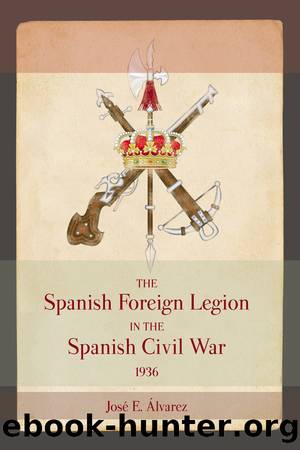The Spanish Foreign Legion in the Spanish Civil War, 1936 by José E. Alvarez

Author:José E. Alvarez [Álvarez, José E.]
Language: eng
Format: epub
ISBN: 9780826273604
Publisher: University of Missouri Press
The Madrid Front
November 1936
ON NOVEMBER 1, 1936, the Nationalist drive toward Madrid was in full gear, with the prize of capturing the capital in sight. The First Bandera, as part of Lieutenant Colonel Fernando Barrónâs column, took part in the drive to capture Humanes de Madrid, southwest of Madrid.1
On November 1 the Fourth Bandera arrived in Villamanta from Valdemoro at four oâclock in the morning. From Villamanta it then set out for Villamantilla and captured the town without encountering any resistance. The bandera continued its advance toward Villanueva de Perales and took it, again without meeting any resistance from government forces. From Villanueva de Perales the Fourth Bandera moved toward Brunete, west of Madrid. It reached the MadridâChapinerÃaâSan MartÃn Valdeiglesias crossroads and proceeded into Brunete, which had already been occupied by Lieutenant Colonel Carlos Asensioâs column. The Fourth Bandera provided security for Brunete and enjoyed a couple of days off for rest and recuperation.2
Under the command of Captain Carlos Tiede, the Fifth Bandera was reviewed and inspected on November 1 by the recently promoted Lieutenant Colonel Antonio Castejón in ChapinerÃa, a village about thirty miles from Madrid. At five oâclock in the morning the Fifth Bandera, as part of Castejónâs column, began its march toward Brunete, but upon reaching the intersection of the roads to Brunete and Villamantilla, it ran into another Nationalist column (Lieutenant Colonel Francisco Delgadoâs column, which included the Fourth Bandera) headed for Brunete, so it diverted to Villamantilla, where it spent the night. The following day it left at daybreak for Sevilla la Nueva, south of Brunete; it arrived seven hours later and spent the night there.3
The Sixth Bandera, as part of Asensioâs column, departed Navalcarnero on November 1 at ten oâclock in the morning. The dayâs mission called for the occupation of Sevilla la Nueva and Brunete. The occupation of the former was accomplished without resistance, but the situation was quite the opposite in the latter. The Republicans in Brunete put up a stiff resistance, fighting handâtoâhand combat in some cases, but were eventually defeated by the legionnaires. Many prisoners were taken as well as great quantities of weapons and materiel. However, the Sixth Bandera paid a heavy toll in the fight for Brunete, suffering twentyâfive dead or wounded. The Sixth Bandera remained in Brunete until November 3, successfully repelling numerous counterattacks by Republicans who were hoping to regain control of the town.4
For the Eighth Bandera November 1 began with an attack on its forces coming from the hills to the southeast of Parla. The Republicans deployed eight Soviet tanks with two battalions of foreigners and various companies of the Assault Guard. The Thirtieth Company of the Eighth Bandera was in charge of defending that sector and suffered some difficult moments as it engaged the advancing Republicans. Fortunately, at the crucial moment that the Republicans pressed their attack, the Thirtieth Company received reinforcements that were sufficient to blunt the Republicansâ assault.
The following day the Eighth Bandera, as part of Lieutenant Colonel Heli Tellaâs column, left Parla for Pinto and captured it after engaging in a brief firefight with the townâs defenders.
Download
This site does not store any files on its server. We only index and link to content provided by other sites. Please contact the content providers to delete copyright contents if any and email us, we'll remove relevant links or contents immediately.
Blood and Oil by Bradley Hope(1531)
Wandering in Strange Lands by Morgan Jerkins(1374)
Ambition and Desire: The Dangerous Life of Josephine Bonaparte by Kate Williams(1346)
Daniel Holmes: A Memoir From Malta's Prison: From a cage, on a rock, in a puddle... by Daniel Holmes(1295)
It Was All a Lie by Stuart Stevens;(1265)
Twelve Caesars by Mary Beard(1258)
The First Conspiracy by Brad Meltzer & Josh Mensch(1140)
What Really Happened: The Death of Hitler by Robert J. Hutchinson(1131)
London in the Twentieth Century by Jerry White(1114)
Time of the Magicians by Wolfram Eilenberger(1089)
The Japanese by Christopher Harding(1086)
Twilight of the Gods by Ian W. Toll(1085)
Cleopatra by Alberto Angela(1063)
A Woman by Sibilla Aleramo(1054)
Lenin: A Biography by Robert Service(1046)
The Devil You Know by Charles M. Blow(987)
Reading for Life by Philip Davis(973)
The Life of William Faulkner by Carl Rollyson(925)
1965--The Most Revolutionary Year in Music by Andrew Grant Jackson(924)
